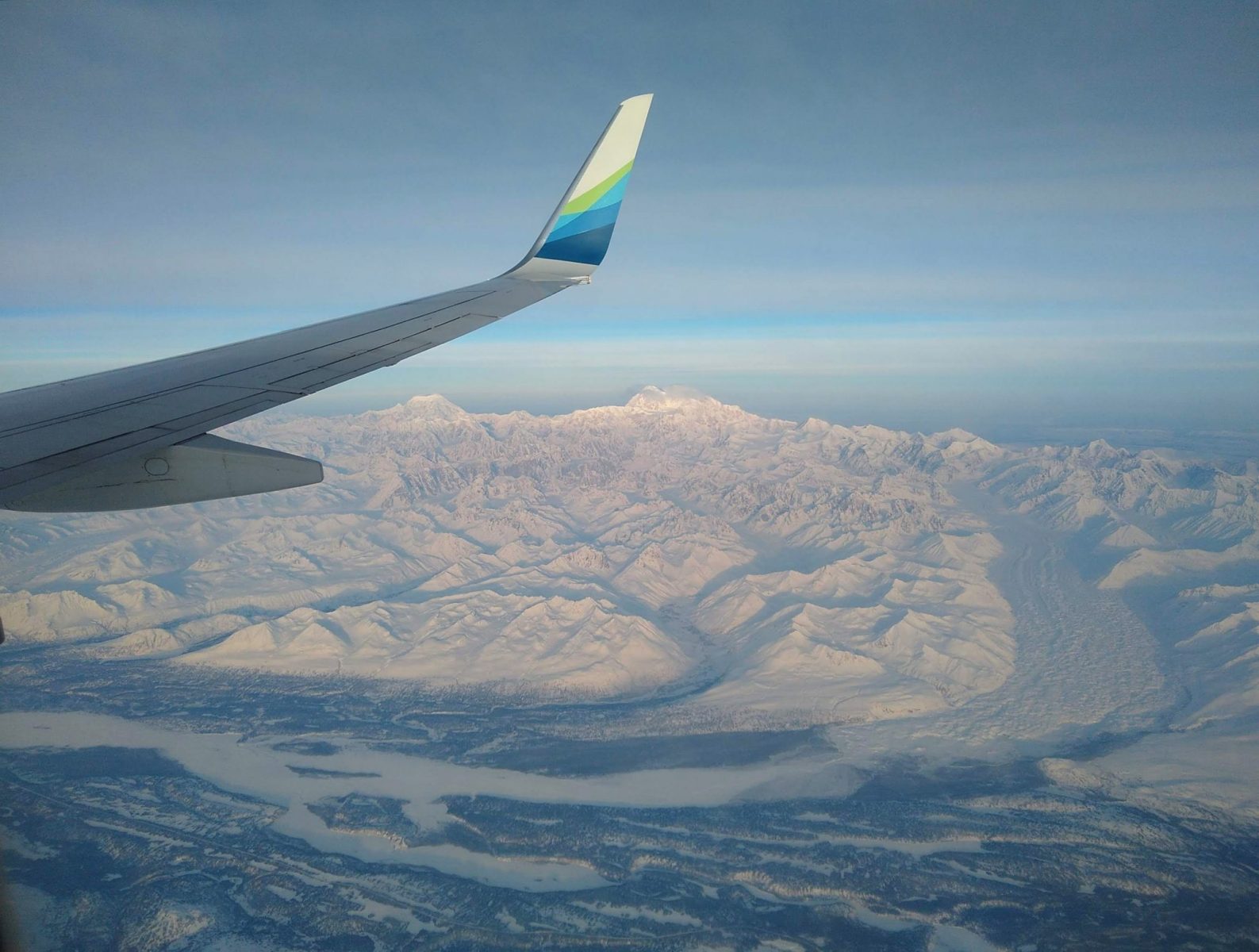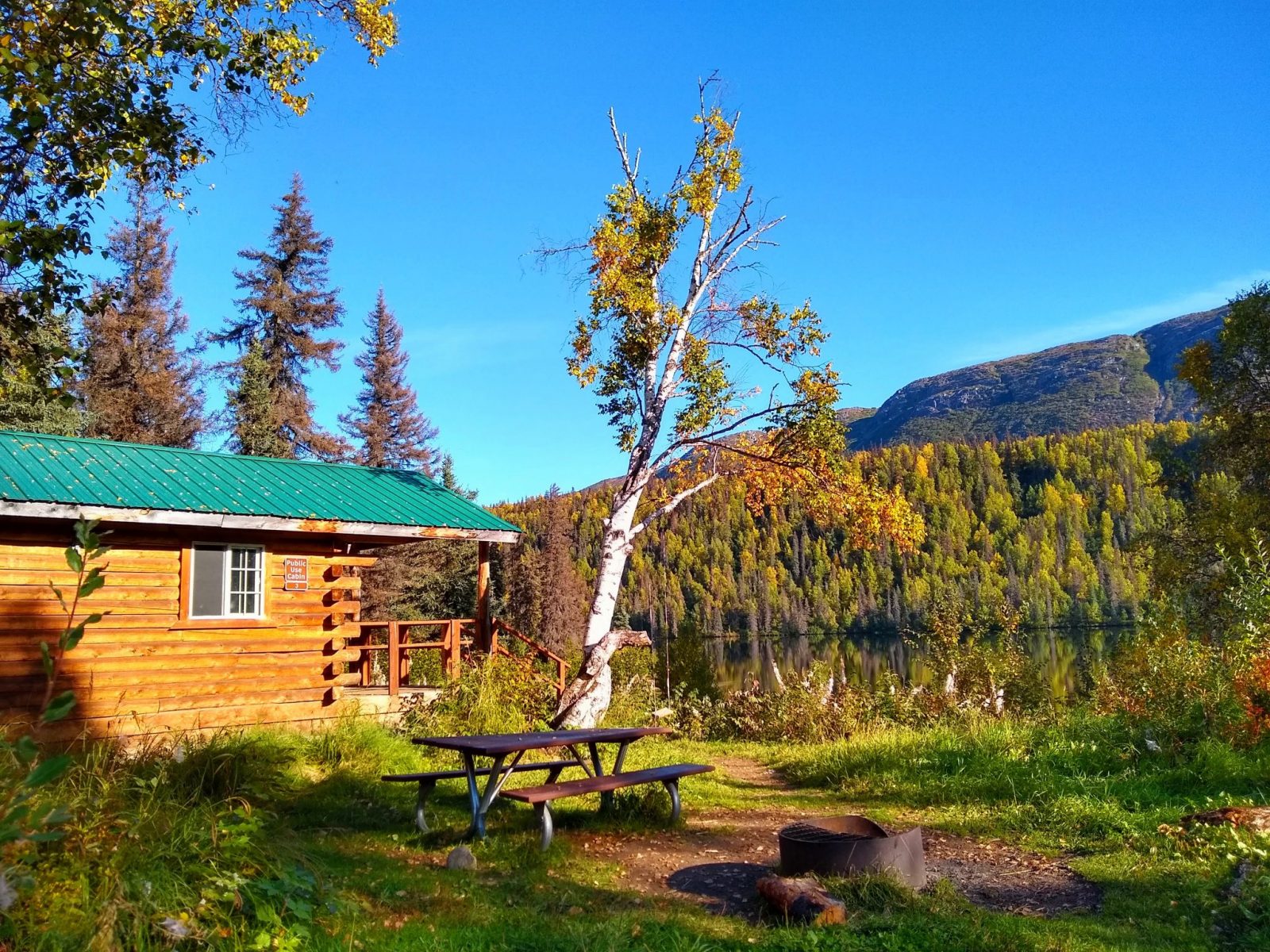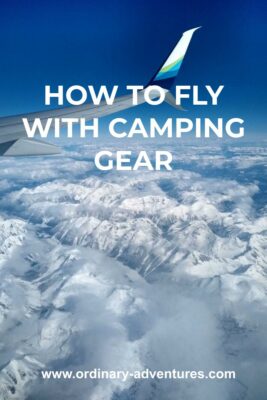How to Fly to Alaska with Camping Gear
Last Updated on December 17, 2024
Getting ready for that epic camping adventure but need to fly to get there? Wondering how to fly with camping gear and backpacking gear and what you can and can’t bring on a plane? If so, then this article is for you! One of the challenges of camping in Alaska or somewhere else that most people fly to is figuring out how to get to your camping trip destination with your gear. I’m here to help with a checklist of what goes in checked baggage, carry on baggage and how to pack it.

- What gear can and can’t go on a plane and what needs to be in a checked bag?
- How to pack camping gear for your flight
- How to get camping gear you need when you reach your destination
- Alternatives to flying with camping gear
Can I bring Camping Gear on a Plane?
Can I fly with a camping stove? Can I fly with a tent? Yes! But there are some restrictions. You can check the TSA restrictions for what you are allowed to bring here.
An important thing to note is that you are almost certainly going to need to check at least one bag if you are going to fly with camping gear.
Camping gear that must go in your CHECKED bags
The bottom line is that anything that could possibly be interpreted as a weapon or could ever be used as one must go in your checked bag if it is allowed to fly at all (for example, bear spray could be a weapon but you cannot bring it on a plane at all).
- Tents – technically, it’s only the tent poles and tent stakes that need to be checked, the actual tent material can be carried on. Since you need the stakes and poles, I recommend leaving the tent in it’s bag with everything together and checking the whole thing
- Trekking poles or hiking poles – if you use poles for hiking or walking (highly recommended!) make sure these are in your checked bag. They are not allowed in carry ons
- Knives – all types of knives must be in checked bags
Camp Stoves (recommend taking in carry on)
Camp stoves are a bit of a special item. They ARE allowed on planes, as long as they are clean and do not have any fuel or fuel residue. Bringing a stove where this is easy to see makes it much easier. I highly recommend bringing your stove in your carry on bag for two reasons
- It’s somewhat fragile and can be easily bent or damaged in the tossing around of checked bags
- TSA officers are likely to inspect it. Be ready for this. I think it’s much easier to have it at the top of my carry on and easy to pull out for inspection than buried in a checked bag (although that can also always be checked anytime). See TSA’s guidance for camp stoves here.
Camping gear that you can’t take on a plane
There are four common pieces of camping gear that you can’t bring on a plane at all, even in checked luggage:
- Camp stove fuel – no camp stove fuel of any kind is allowed on board a plane
- Bear Spray – a common item for camping or hiking in bear country, bear spray is a larger can of pepper spray (also not allowed). Bear spray cannot be brought on board a plane at all
- Lighters – an exception is a lighter that can be filled and emptied of fuel (like a zippo). If it’s clean and empty, it can be carried on or checked
- Strike Anywhere Matches – you CAN bring safety matches but ONLY in your CARRY ON bag. Safety matches are matches that require the special strip on the side of the box to light them (as opposed to rocks or other materials in strike anywhere matches)
How do you pack Camping Gear for a plane?
The most important thing to think about when packing camping gear for a flight is to pack light. The importance of this cannot be overstated! You want to make sure that you have everything you need for a safe and fun adventure while not adding anything you don’t need. If your camping gear is specifically designed for backpacking, it will generally be lighter and smaller and this is a big bonus. If you can use something for more than one purpose, this will also help. For example your sleeping pad can double as a camp chair and your sleeping bag can double as a blanket.
Make sure to weigh and measure your bags to ensure they will fit in the requirements for size and weight for your airline.
What type of bag should I pack my camping gear in for flying?
I recommend either bringing it in a backpack or in a large duffel bag. Unless you’re backpacking (camping for multiple nights that you hike in to), I recommend a large duffel. Make sure to mThe duffel has some advantages over a backpack including:
- You can fit a lot in it, especially bulky items like sleeping bags and tents
- You can get a waterproof one (I highly recommend waterproof, especially in the Pacific Northwest and Alaska)
- You can get one with backpack straps that tuck away so they can’t be damaged but you can still carry it on your back for a shorter distance such as to and from a shuttle, rental car, train or boat.
If you are going on a backpacking trip, or a big backpack is the best option you have to pack in, I recommend a couple of steps to protect your backpack during travel:
- Adjust all the straps and hooks as tight as possible to limit how much they can tear or be damaged
- Put the backpack inside a large plastic bag – this protects the straps from damage. TSA may open the bag, or it could get torn, so make sure to put a label with your name, phone number and email on the backpack INSIDE the plastic bag (not outside only). Alaska Airlines provides sturdy see through plastic bags for a variety of items, so if I’m flying Alaska I just get the bag at the airport.
A couple more tips: using packing cubes can help keep things organized in a bigger bag and make it easier to find small items quickly. Compression sacks can help pack down bulky items (especially sleeping bags, jackets and other clothes) to a smaller size which is helpful for backpacking and also packing to fly with camping gear.
How to get camping gear you can’t fly with when you get to your Destination
If you need to pick up fuel for your camp stove, bear spray or lighters, plan on purchasing these when you get to your destination.
Lighters are pretty easy to find in any grocery store, drug store or convenience store.
Camp stove fuel is usually fairly easy to find in areas with lots of campers. If you are going to a remote location, check in advance to find out where you can purchase the appropriate fuel for your stove. Make sure to ask for the specific type of fuel you need or the type of stove you have.
If you’re traveling somewhere where you need bear spray (especially in Alaska), find out where you can purchase it at your destination before you leave and make a plan. Bear spray is fairly easy to find in Alaska and it’s one of the few things that tends to be less expensive than in other parts of the US. If you are buying it in a remote location however, it’s expensive. A good option for bear spray is to check with your vacation rental host, hotel or tour operator to find out if they have extra bear spray laying around that was left by other travelers who couldn’t fly home with it. If you’re heading to a national park, you can also check with rangers there to see if they have them leftover from others.
I also recommend getting items like bug spray and sunscreen when you arrive at your destination although they are allowed in your checked bag as long as they are not in an aerosol spray container.
Alternatives to flying with Camping Gear
After figuring out how to fly with camping gear, if it seems like more of a hassle than you want to deal with, there are a few alternatives to consider:
Rent it
It is possible to rent camping gear! You can always google “rent camping gear” and your destination and see what the options are. Arrive Outdoors will ship your rental gear to any home, hotel or Fedex location nationwide. They have a partnership with Washington State Parks which allows your to rent camping gear for your trip in a Washington State Park.
Alaska Outdoor Gear Rental rents camping gear as well as lots of other gear and provides trip planning for your Alaska Adventure. You can get your gear at the airport, Alaska Railroad, Cruise ship terminal and more. They even have some one way camping gear rental options which could be a good option if your Alaska itinerary involves going into one city and out of another.
If your camping trip starts near an REI store (such as Seattle, Spokane, Anchorage or Fairbanks) you can also rent from them. Not all REI stores have all types of camping gear for rent so make sure to check in advance.
If you are interested in renting instead of figuring out how to fly with camping gear, make sure that you reserve far in advance and make sure they have the items you need and that they have availability for your travel dates.
Ship It
You can ship your camping gear to your destination, as long as you have a place to send it! Make sure that you have a place that will receive your shipment and check with them to confirm they can receive and store your camping gear. Don’t assume this is possible!
Another tip regarding shipping: If you’re shipping gear to Alaska, I recommend using the US postal service rather than FedEx or UPS. Both FedEx and UPS will require you to pay for overnight or second day air shipping which is a lot more expensive.
If you are shipping your camping gear, make sure you send it in plenty of time to account for any delays.
Take an organized trip which includes gear
Many organized tours and trips include the gear you need. For example, most kayak operators in Washington and Alaska provide at least some of the gear you need in addition to just your kayak and paddles. Fishing charters often provide rubber boots in addition to all the fishing gear.
Backcountry multiday trips often include all the camping gear and supplies you need, which is something to consider if you want to avoid flying with camping gear or dealing with gear at all.
Make sure to ask about the gear you need and what is provided when booking any kind of outdoor adventure through a tour operator.
Consider alternatives to camping or ways to bring less gear
Another possibility is to consider alternatives to camping when you arrive at your destination. You’ve probably already considered hotels and vacation rentals and decided you’d like to camp. Even if you are camping, there are a few ways to structure your camping experience so you need less gear, including:
- In Washington and Alaska (and many other states), public use cabins and yurts are available for rent. The forest service has some as well as state parks in both states. In British Columbia, there are permanent cabin wall tents available for rent in many campgrounds. Each place offers different amenities, but you might be able to avoid bringing some of your gear, especially a tent. Some cabins have cooking stoves as well. You will always need to bring your own bedding and food. Check before booking to make sure you know what is provided and what you need to bring. This feels like camping but you can bring a bit less gear (and have some weather, bear and bug protection too!)

- In some National Parks in Alaska and Washington, there are lodges near some camping areas (not all, make sure to check this in advance!). This can provide another way to have a hot meal without bringing a camp stove or dealing with finding stove fuel. In Glacier Bay National Park, the lodge has a dining room (complete with a covered deck) a quarter of a mile from the Bartlett Cove campground. In Olympic National Park, there are lodges with dining at Sol Duc Hot Springs as well as Kalaloch Beach and Lake Quinault.











